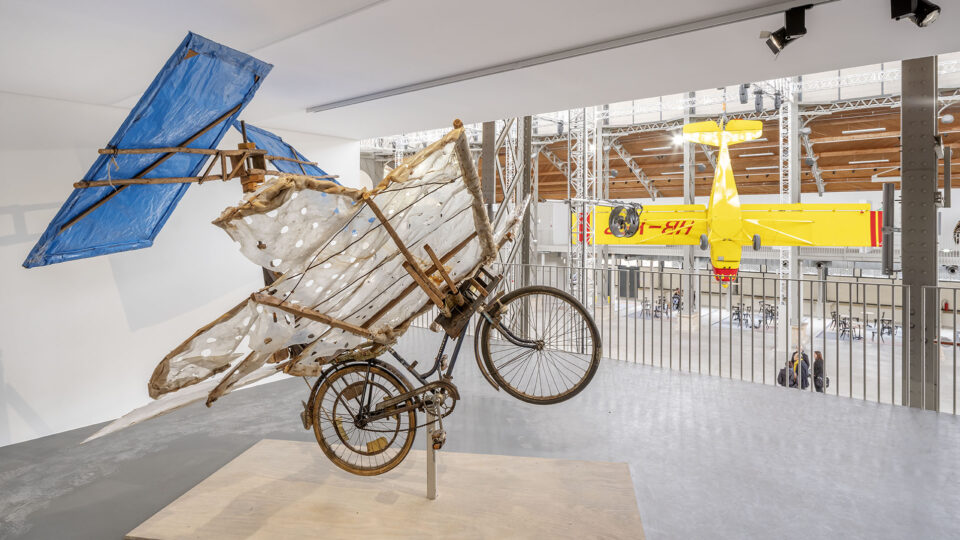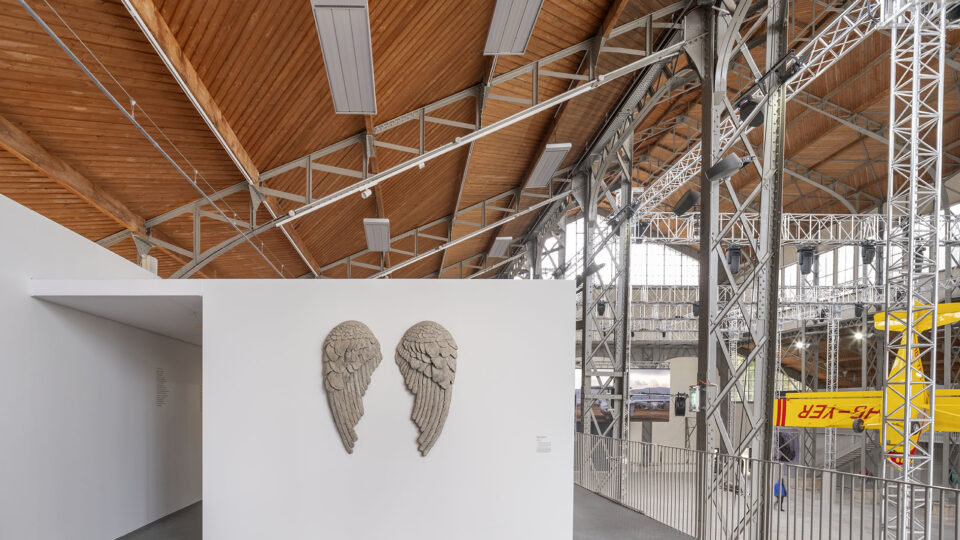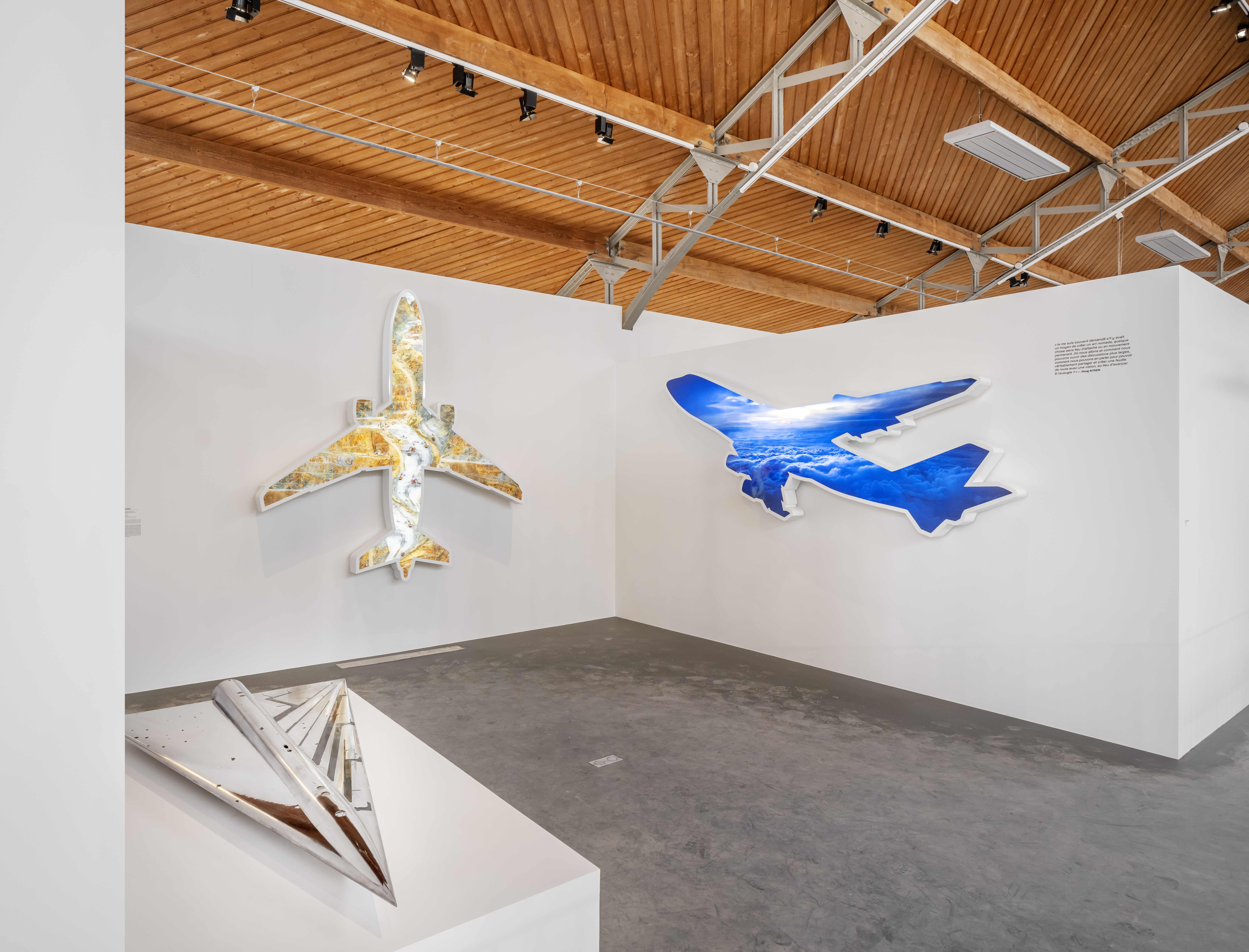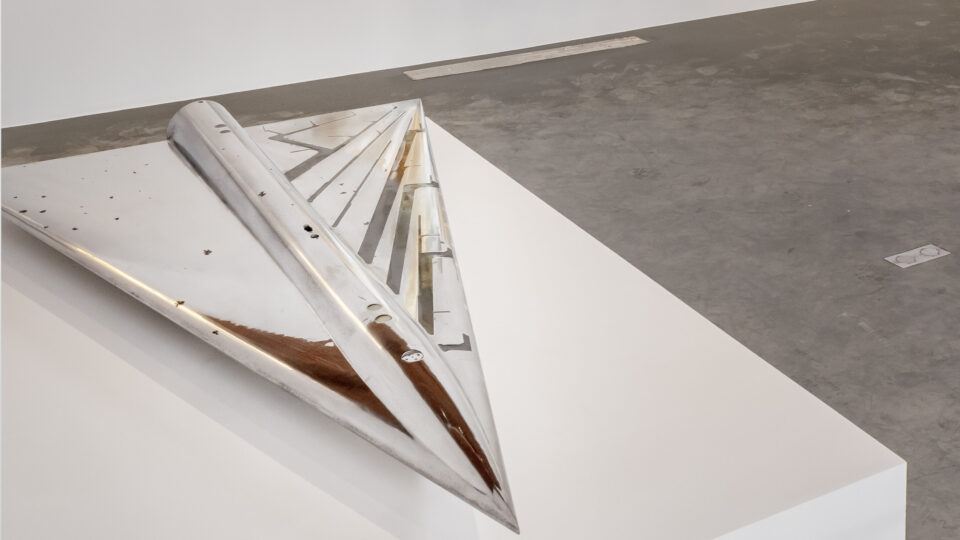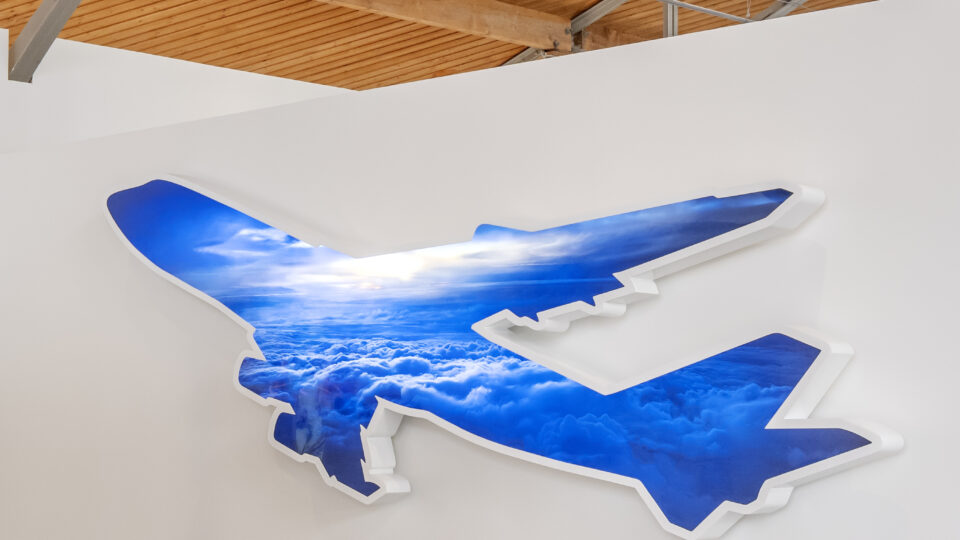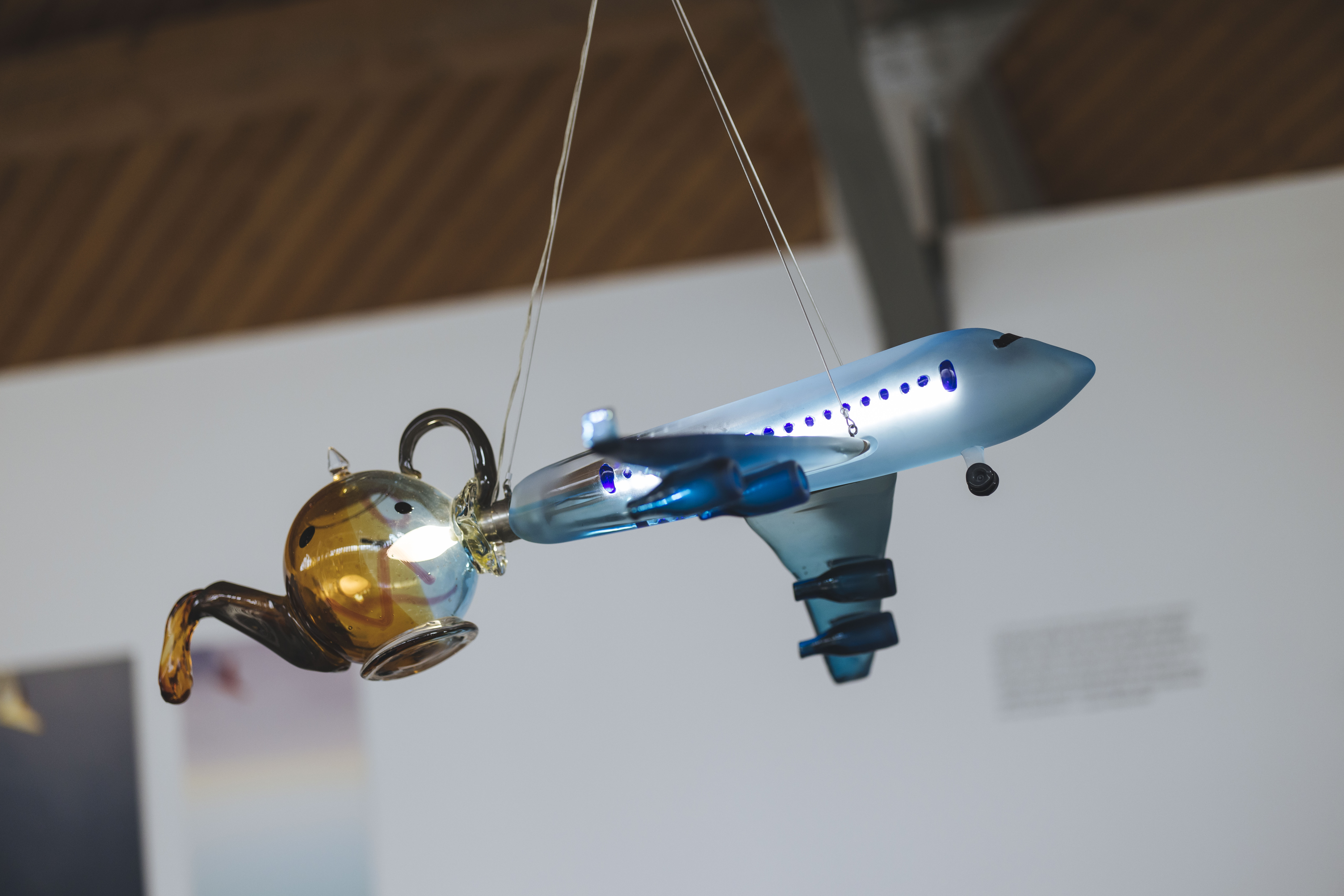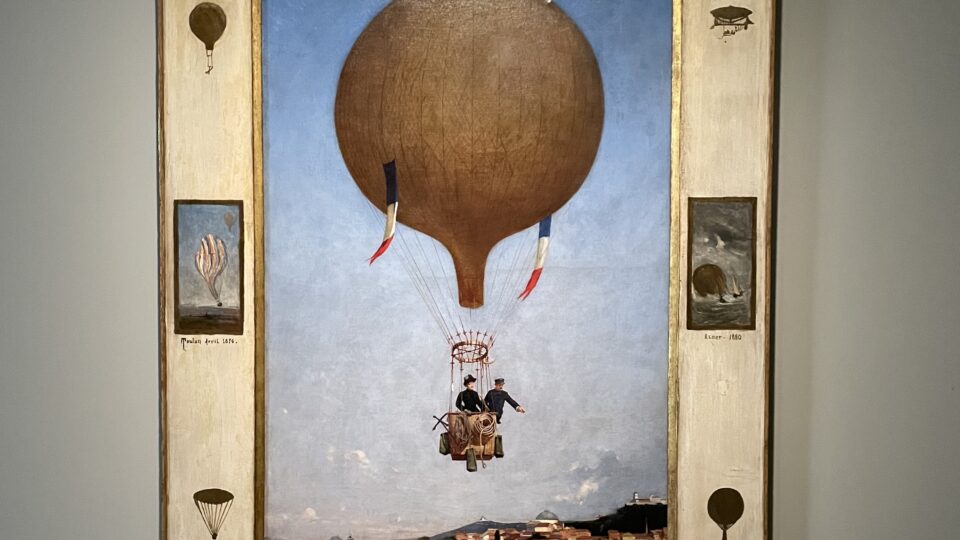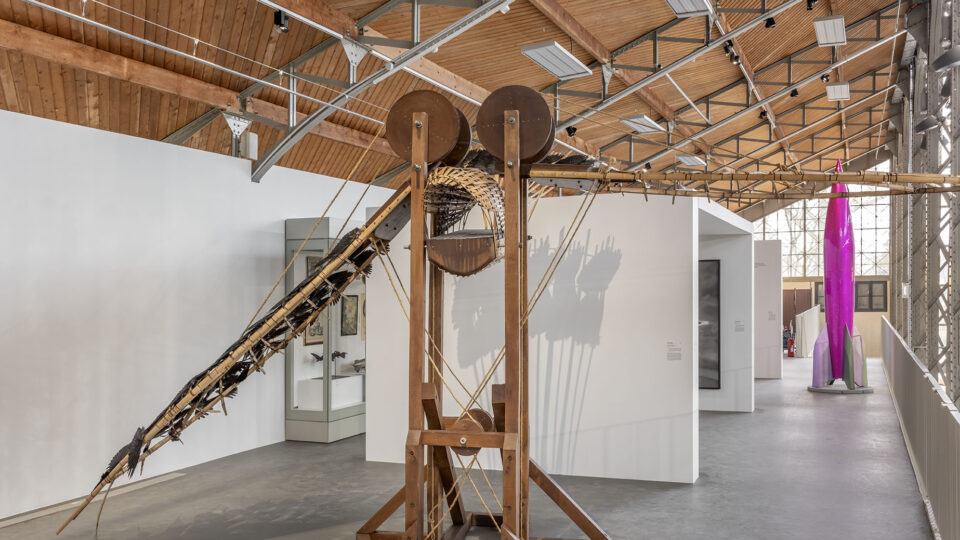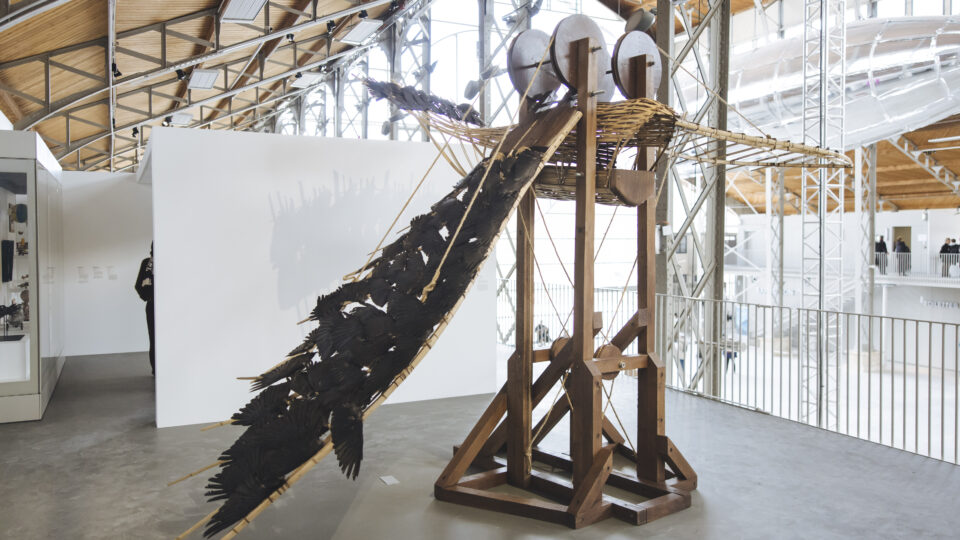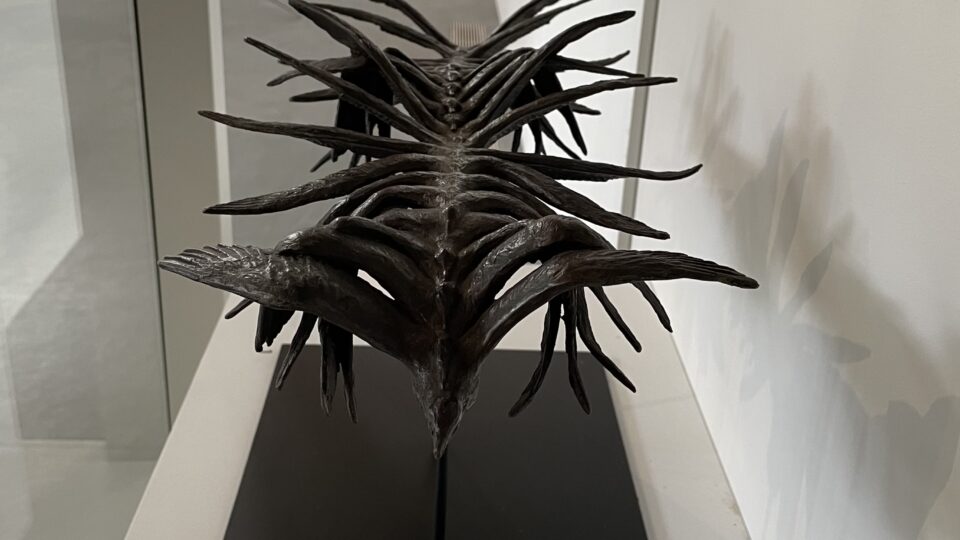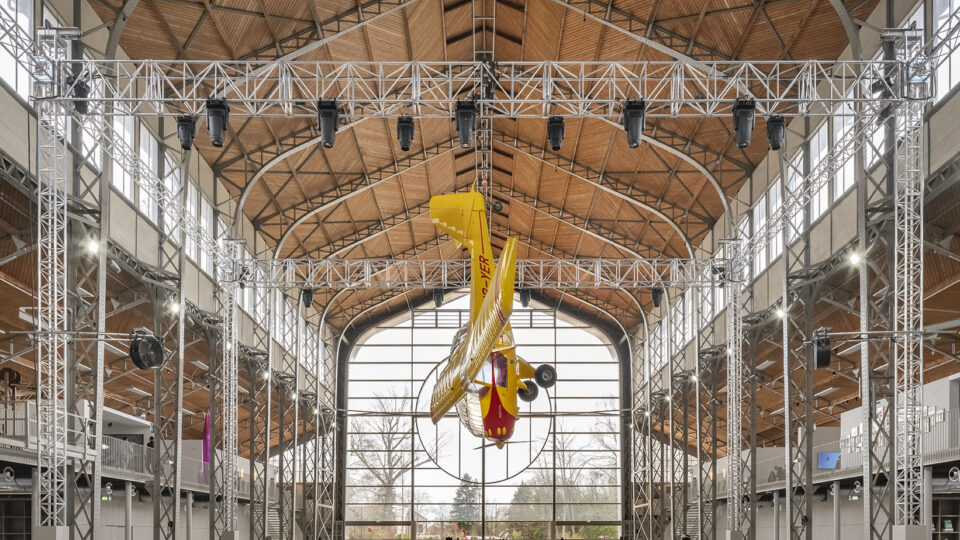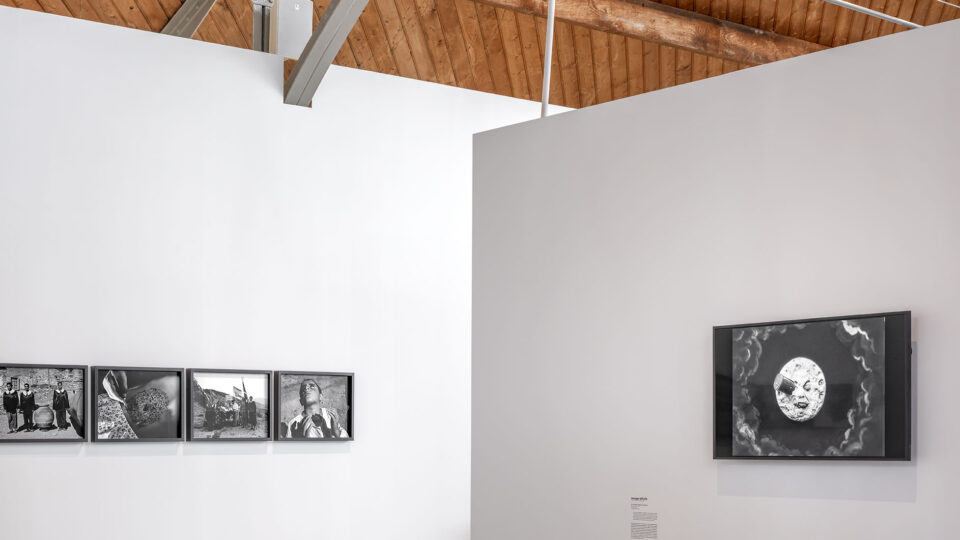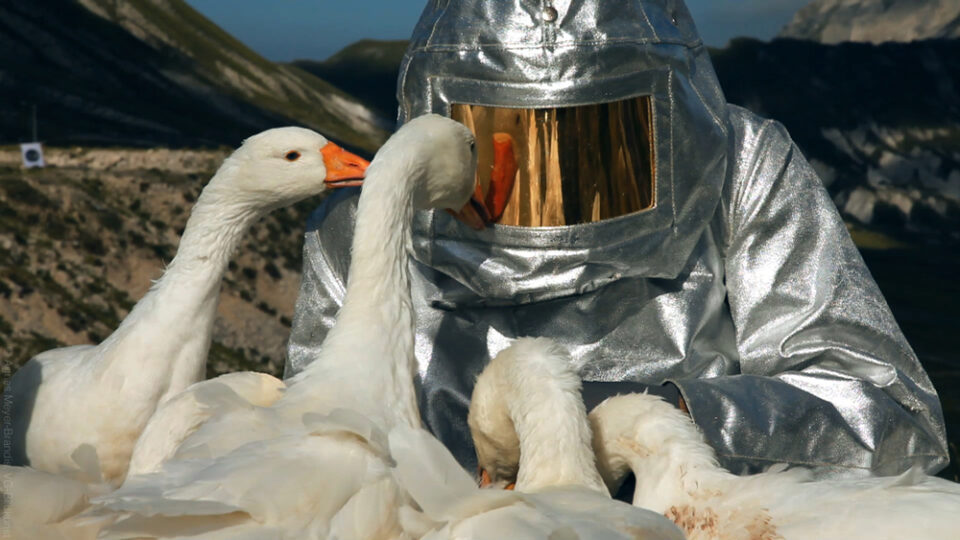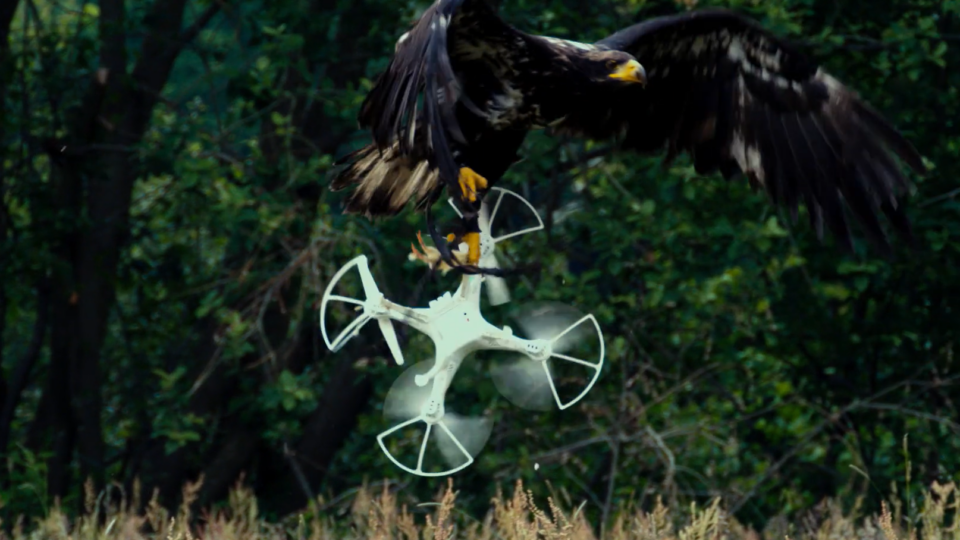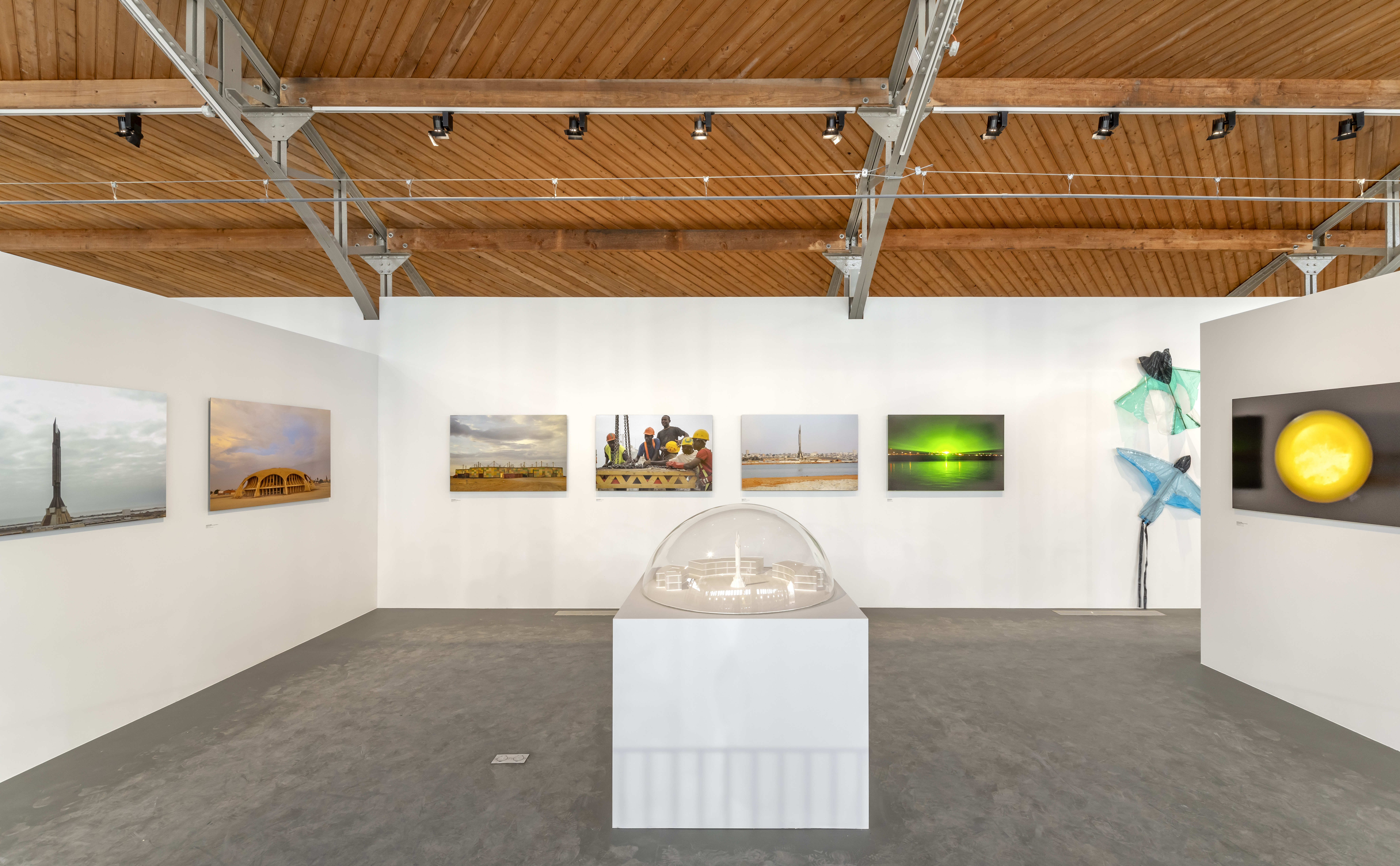Pourquoi Icare a-t-il chuté ?
AVANT-PROPOS
Entre réalité et fiction, sciences contemporaines et mythologie, cette enquête propose une lecture décalée de l’exposition « Dans l’air, les machines volantes » en singularisant quatorze œuvres exposées pour développer quatorze hypothèses spéculatives sur la chute d’Icare.
Chacune de ces hypothèses est indépendante. Quels indices ces œuvres révèlent-elles de notre rapport aux machines et à la science, de l’héritage technologique à un moment où il est devenu si difficile de se projeter dans un futur désirable. Quel rapport au Temps-espace, à l’irréversibilité de la chute ? Alors même si vous croisez le lapin blanc d’Alice déclarer en courant «Oh dear! I shall be too late!» prenez votre propre Temps et perdez-vous dans les dimensions parallèles, où ces fiches sont les portes.
Jean-Marc Chomaz
Artiste physicien, Directeur de recherche CNRS, Professeur à l’École polytechnique.
INTRODUCTION
Objet : éluder le crash d’un appareil volant
Concepteur : l’artisan ingénieur Dédale
Pilote : Icare
Rapport d’accident :
Plusieurs siècles avant notre ère, dans la Grèce antique, l’artisan ingénieur Dédale et son fils Icare font le premier test d’une machine volante et décolle du Labyrinthe en Crète. Le roi Minos les avait enfermés pour punir Dédale d’avoir révélé à Ariane la solution pour entrer et ressortir du Labyrinthe : un fil, que le beau Thésée accroche à la porte du labyrinthe, déroule derrière lui et suit pour revenir en arrière.
Une heure après le décollage, l’appareil piloté par Icare s’abime en mer. Icare avait choisi une autre route aérienne que Dédale, resté en vol à faible altitude, au ras des flots. Icare, lui, vole haut. Dédale ne prête pas attention à son fils qui, peut-être, enivré par le vol aura voulu voir la Terre du ciel.
Thèse officielle…
et controverses scientifiques :
La thèse officielle retient la responsabilité du pilote, monté si haut, que la cire maintenant les plumes de ses ailes a fondu.
Cependant, cette thèse ne résiste pas à l’analyse scientifique, le Soleil étant trop loin de la Terre, même en ces temps mythologiques, pour que la chaleur de sa lumière varie en montant dans l’atmosphère. Bien au contraire, il est de l’expérience de chacun que la température décroît rapidement en s’élevant dans le bleu métallique de l’azure. En montagne, la décroissance est en moyenne de deux degrés (2°C) lorsque l’on s’élève de 300 mètres, 12°C de moins à 2000 mètres, il vaut mieux s’habiller chaudement !
L’enquête est ouverte !
A travers de nombreux dessins, maquettes, sculptures, vidéos et installations, parcourez cette exposition telle une enquête menée par un grand nombre d’artistes et de scientifiques.
Une enquête secrète dont les preuves sont encore codées par le poids de la thèse officielle qui porte la faute sur l’inconscience du fils et dédouane autant le père, le système, la machine, la mécanique, la physique et l’inconscient que l’homme, sa technique et ses dieux.
Hypothèse N°1
Turbulence, instabilité absolue du sillage de l’aile et croissance transitoire des perturbations dans les couches limites sur l’intrados et l’extrados de l’aile (les surfaces interne et externe par rapport à la cambrure de l’aile.)
La poète Ovide rapporte la façon dont Dédale attache des plumes d’oiseau aux ailes, il « dispose des plumes avec ordre, en prenant d’abord la plus petite ; chacune d’elles est moins longue que celle qui la suit, et toutes s’élèvent par une gradation insensible… Dédale attache ces plumes, au milieu, avec du lin, à leur extrémité avec de la cire ; il leur imprime ensuite une légère courbure, afin de mieux imiter l’aile des oiseaux. [1] »
 Plumes se levant sur une aile d’oiseau pour éviter l’extension de la zone où l’écoulement est séparé [2].
Plumes se levant sur une aile d’oiseau pour éviter l’extension de la zone où l’écoulement est séparé [2].
Mais les recherches récentes[2][3][4] ont montré que, de la mobilité des plumes, dépendaient la stabilité de l’écoulement autour des ailes des oiseaux. Les plumes des ailes des chouettes contrôlent si bien l’écoulement que leur vol devient silencieux, sans l’émission sonore du frottement turbulent de l’air, sans les consonnes fricatives produites par les tourbillons.
Les plumes de la machine de Dédale auraient alors été trop fortement liées créant l’instabilité fatale pour Icare qui, changeant d’altitude, a expérimenté d’autre régimes de vol que Dédale.
Les fossiles des dinosaures ailés montrent en effet l’évolution des attaches des plumes probablement pour optimiser la stabilité du vol plané et voler plus loin.
[1] Ovide, Métamorphoses VIII vers 236-259; [2] D. Bechert, M. Bruse, W. Hage et al., “Biological surfaces and their technological application—laboratory and flight experiments on drag reduction and separation control,” in 28th Fluid Dynamics Conference, Snowmass Village, CO, USA, 1997; [3] Lishu Hao , Yongwei Gao , Binbin Wei , and Ke Song, “Numerical Simulation of Flow over Bionic Airfoil” International Journal of Aerospace Engineering, Volume 2021, Article ID 5556463 ; [4] Artur Reiswich, Max Finster, Martin Heinrich, Rüdiger Schwarze, “Stereo vision investigation of elastic flap kinematics inseparated flow” Journal of Fluids and Structures 114 (2022) 103711
Hypothèse N°2
Le créateur est dépassé par sa création : l’automate
Dédale est humain mais, initié par les dieux, il se rêve démiurge (créateur de l’univers) et thaumaturge (faiseur de miracles). Comme des automates ou des robots, les statues qu’il forge, les agalmata, semblent vouloir bouger et imiter la vie.
Peut-être, que cette machine volante, créée par Dédale, aurait dû être attachée pour éviter d’en perdre le contrôle et que, se croyant autonome, ne s’échappe.
De nos jours, il faut encore parfois ligoter les maquettes d’aéronef pour éviter qu’elles ne s’enfuient et ne provoquent un accident mortel.
Hypothèse N°3
Le trou d’air, ou le poids du vide
Expérience : prenez un cadre rectangulaire, plongez-le dans une eau savonneuse, retirez-le doucement pour garder un film de savon tendu sur le cadre, placez le cadre verticalement, prenez un cheveu très fin et nouez-le pour former une boucle, plongez la boucle dans le film de savon, avec une aiguille, percée le film à l’intérieur de la boucle. Instantanément la boucle de cheveux se tend pour former un ballon à deux dimensions.
Le rien à l’intérieur du ballon est plus léger que le film de savon dans lequel il est plongé, comme si la poussée d’Archimède était valable dans la mini atmosphère à deux dimensions que constitue le film de savon.
Le trou « d’air », emprisonné par le cheveu, monte dans le film attiré par une force égale au poids de la membrane de savon qui occuperait l’intérieur de la boucle si l’aiguille ne l’avait pas percée.
Un trou d’air aurait pu faire tomber l’appareil d’Icare et provoquer l’accident.
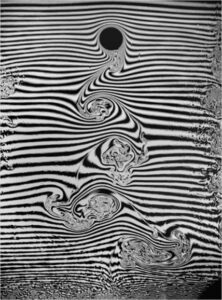
J.-M. Chomaz, “Terra Bulla, the influence of Yves Couder on the emerging domain of arts and physics sciences”, Comptes Rendus Mécanique, Vol. 348, pp.447−456. (2020)
Dans un film de savon tendu verticalement sur un cade d’étain, une surface vide entourée d’une boucle de cheveux est en ascension et laisse derrière elle des milliers de tourbillons. Les stries noires et brillantes sont les franges d’égale épaisseur du film qui apparaissent par interférences lumineuses lorsque le film est éclairé en lumière monochromatique ici émise par une lampe au sodium.
Y. Couder, J.M. Chomaz, Marc Rabaud. On the hydrodynamics of soap films. Physica D: Nonlinear Phenomena, 1989, 37 (1-3), pp.384-405.
Hypothèse N°4
Stabilité de l’aile, décrochage et chute en vrille
Erreur de dessin de l’aéronef
Comme pour les premières ailes volantes, en forme de Delta de type Rogallo des années 1970, et celles dessinées pour les premiers avions, les ailes qui ne sont pas assez rigides perdent leur portance à certain angle d’attaque, et tombent alors en vrille, sans possibilité de redresser l’engin.
Cette situation aurait pu arriver à Icare si, après être monté plus haut que Dédale, il avait voulu revenir vers lui et piquer alors vers le bas. La responsabilité du crash incomberait alors au concepteur et à l’ignorance des propriétés de stabilité des ailes en ces temps premiers.
Hypothèse N°5
Un panache thermique aurait emporté Icare
Des siècles après Dédale, dans la Grèce antique, le philosophe Aristote[1] [2]a théorisé l’ordre du cosmos. La Terre est sphérique au centre d’un Ciel clos lui aussi sphérique. Dans le domaine sublunaire, chacun des quatre éléments qui forme toute matière terrestre possède une qualité intrinsèque la gravité, la terre et l’eau vont vers le centre de la Terre, l’air et le feu se dirigent vers la périphérie du monde sublunaire.
L’ordonnancement de ce cosmos antique pourrait expliquer la recommandation de Dédale à son fils : rester entre l’eau et l’air pour ne pas monter ni descendre et surtout éviter le feu tout en haut.
Dans la vision moderne, l’air chaud, au-dessus d’un champ de blé ou d’une falaise éclairée par le Soleil, monte et forme des panaches thermiques. Ces derniers sont appelés « pompes thermiques ». Les parapentes et les planeurs les connaissent bien car elles les attirent, les attirent et les attirent vers le haut….
Mais Dédale et Icare ignorent encore la physique d’Aristote et celle des savants d’aujourd’hui. Un panache thermique aurait pu emporter, par la qualité ascensionnelle du feu, Icare vers le haut. Plus léger que son père, Icare serait monter plus haut et ses ailes auraient alors fondues, avant d’atteindre la trajectoire de la Lune.
Les Montgolfières utilisent ces qualités antigravitationnelles du feu pour voler, ce sont des vols de « plus léger que l’air » qui pour d’Aristote représente le feu.
Le premier engin « plus léger que l’air » décolle le 19 septembre 1783, conçu par Joseph et Étienne Montgolfier, il est constitué d’une pièce de tissu contrecollé de papier des deux côtés qui, gonflée par un feu de laine et de paille mouillée, prend la forme d’un ballon de 13m de diamètre auquel est accroché un panier d’osier embarquant un mouton, un canard et un coq.
[1] Aristote, 2004. Traité du Ciel, trad. C. Dalimier et P. Pellegrin, Paris, Flammarion, 465p.
[2] Éventuellement citation « En deçà de cette nature éthérée et divine, ainsi ordonnée, et comme nous l’avons dit, immuable, inaltérable, impassible, est placée la nature muable et passible, en un mot, corruptible et mortelle. Elle a plusieurs espèces, dont la première est d’une essence subtile, inflammable, qui s’allume par la masse et le mouvement rapide de la substance éthérée. C’est dans la région ignée et désordonnée, que brillent les phénomènes lumineux, les flèches ardentes, les verges et les gouffres enflammés ; c’est là que sont fixées les comètes, et qu’elles s’éteignent souvent.
Au-dessous de cette région est répandu l’air, ténébreux et froid de sa nature, qui s’échauffe, s’enflamme, devient lumineux par le mouvement. C’est dans la région de l’air, passible et altérable de toutes manières, que se condensent les nuages, que les pluies se forment, les neiges, les frimas, la grêle, pour tomber sur la terre. C’est le séjour des vents orageux, des tourbillons, des tonnerres, des éclairs, de la foudre, et de mille autres phénomènes. »
Aristote, Lettre d’Aristote à Alexandre, chapitre II, § 1-9, tr. fr. Charles Batteux, revue et corrigée par M. Hoefer, Lefèbre, 1843
Hypothèse N°6
Le créateur est dépassé par sa création : le cyborg
Dans sa fascination pour son art et les technologies qu’il invente, Dédale crée le premier cyborg, mi femme mi machine pour Pasiphaé, l’épouse de roi de Crète Minos.
Minos n’a pas voulu tuer le magnifique taureau blanc qu’il avait demandé à Poséidon pour sacrifice.
Furieux Poséidon a inspiré à Pasiphaé un désir irrépressible pour le fabuleux animal. Usant de toutes ses ruses et de tout son art, Dédale crée un cyborg, une vache mécanique ou rentre Pasiphaé pour séduire le taureau.
De cette union nait Astérion, un enfant hybride mi-homme mi-taureau, le Minotaure. Minos demande alors à Dédale de contrôler la créature aberrante qu’il a contribuer à créer. Dédale imagine alors le Labyrinthe, illusion de la perspective qui perd l’esprit et emprisonne le corps.
Mais il trompe de nouveau Minos en donnant la solution du Labyrinthe à Ariane la fille du roi et de Pasiphaé qui désir sauver Thésée. Attacher un fils à la porte d’entrée, dérouler la pelote et la suivre à rebours pour revenir à la porte une fois le Minotaure tué.
Minos enferme alors Dédale et son fils dans le Labyrinthe mais Dédale invente alors un nouvel hybride homme machine oiseau, qui leurs permettent de sortir par les airs et de fuir la Crête.[1]
Mais est-il imaginable que la part machine du cyborg que constitue Icare ailé ait refusé d’obéir à la volonté de la partie humaine, technologie échappant au contrôle de son créateur ?
[1] Phérécyde, FGrHist 3 F 148 = Schol. Odyssée, XI, 322, Dindorf
Hypothèse N°7
Second accident dû à la masse trop importante des machines volantes
La légende prétend que Dédale, jaloux de son neveux et apprenti, Talos, qui allait le dépasser en ingéniosité (ayant inventé alors âgé de douze ans seulement, la scie et le compas), l’aurait précipité du haut du temple d’Athéna, sur l’acropole à Athènes.
La déesse Athéna aurait alors métamorphosé Talos en oiseau avant qu’il ne s’écrase[1]. Au lieu d’une tentative de meurtre, peut-être était-ce là, la première tentative de vol. Première tentative de vol et premier accident aérien qui aurait couté la vie à un homme, Talos.
Sous cette hypothèse, Dédale n’aurait pas précipité Talos pour le tuer. Talos, pilote d’essai, plus léger que Dédale, et équipé d’un dispositif de vol, se serait élancé de lui-même et aurait malheureusement chuté.
La reconstitution d’une machine volante en bois pourrait ainsi le faire penser ! Évidemment ce n’est là que spéculation car cette première tentative de vol et l’existence d’une telle machine ne sont relatées dans aucun récit ancien, seule la réalité de la chute est relatée mais pas les circonstances. Dédale ayant été le seul témoin humain de la chute nocturne de Talos et ayant effacé toute trace de celle-ci. Mais si cette hypothèse était valide alors il reste une question qui de Talos ou de Dédale aurait inventé cette fabuleuse première machine tombée du ciel, fauchée en plein rêve ?
[1] Ovide, Métamorphoses VIII vers 236-259
Hypothèse N°8
Comme une promesse de mouvement : l’arrivée du Temps
Comme nous l’avons décrit pour l’hypothèse 7 de cette enquête, dans la théorie de l’ordre du cosmos énoncée par Aristote, chacun des quatre éléments qui forme toute matière du monde sublunaire se déplace à vitesse uniforme en ligne droite : soit vers le centre du monde pour la terre et l’eau soit vers la périphérie, une sphère sur laquelle s‘inscrit l’orbite lunaire, pour l’air et le feu, la vitesse de déplacement dépendant de l’élément considéré. Ainsi l’espace du monde sublunaire est-il organisé en strates spatiales concentriques, la terre puis l’eau, l’air puis le feu.
La qualité de déplacement centripète ou centrifuge des quatre éléments rajoute la dimension Temps, incarnée par le Dieu Chronos, à cet Espace.
Mais les récits mythologiques se contredisent sur l’arrivée du Temps et donc de la chute des corps : Chronos est-il le fils de Gaïa (la Terre) et d’Hydros (les Eaux primordiales) ? Chronos et Ananké, la déesse de la Nécessité, ont-ils engendré les dieux : Chaos, Aether et Phanes ?
Ou est-ce l’inverse ? Chronos, qui, émergeant du Néant, créa le Terre et l’Espace par l’entremise de Nyx la déesse de la nuit, elle-même apparue avec le Chaos primordial ?
Cette confusion dans l’ordre de la création est dans un sens logique car la causalité n’a pas prise avant l’arrivée du Temps et le Temps en retour n’existe pas sans l’émergence de l’Espace et, comme dans la vision moderne, le Temps-Espace souvent nommé à tort l’Espace-Temps est alors une seule entité.
En effectuant le premier vol, en défiant la chute, en volant haut, il se pourrait qu’Icare ait forcé le Temps-Espace à être regardé comme nous le faisons aujourd’hui seulement dans la direction du Temps, le future étant devant nous et le passé derrière notre tête et inversement. Cette chrono-sculpture, où le Temps n’est pas encore séparé de l’espace, peut en attester. Elle est imaginée par le chercheur du mouvement, le physiologiste Étienne Jule Marey qui projette le Temps-Espace non plus comme un volume ou une image de l’Espace à un Temps donné mais en cumulant plusieurs Temps aux même point de l’Espace. Il invente ainsi l’image mouvement mais pour cela il fractionne le Temps, superpose une série de cliché instantané dans ses chronophotographies.
Hypothèse N°9
Comme une promesse de mouvement : la gravité
Pour les Grecs anciens, la chute est une qualité intrinsèque des quatre éléments, la terre, l’eau, l’air et le feu. Le défi, pour l’art comme pour la science, est alors de faire percevoir (avant de concevoir et de représenter, le Temps-Espace du monde) les éléments et leur qualité ainsi que leur mouvement potentiel de chute. Dédale y était parvenu avec ses sculptures, ses agalmata, qui semblaient vouloir bouger. Créer des machines volantes procède de la même volonté, elles représentent des promesses de mouvement.
Mais la théorie des éléments et de leurs qualités, leur translation uniforme vers le sol ou vers le ciel, était fausse. Newton[1] a démontré cette erreur et a proposé de passer d’un mouvement potentiel à la promesse du mouvement, promesse inscrite dans les Principia Mathematica, les principes mathématiques qu’il construit pour décrire le devenir du cosmos. Ainsi, les lois d’un monde mécanique ne décrivent ni l’espace, ni le mouvement et ni la vitesse de déplacement des choses. Ces lois régissent la promesse de ce déplacement, la variation de la quantité de mouvement des objets, c’est à dire la dérivée par rapport au Temps du produit de la masse et de la vitesse. Le monde n’est donc pas statique (la position, l’Espace seul), ni seulement cinématique (la vitesse, le Temps-Espace de mouvements uniformes rectilignes d’Aristote), mais dynamique (l’accélération et les forces, le Temps-Espace en accélération de Newton). La chute des corps n’est plus alors une qualité des éléments qui le composent mais résulte de l’accélération, appelée gravité, qui donne au Temps son déplacement et au cosmos la loi de l’attraction universelle.
La machine volante de Dédale, pilotée par Icare, avait été conçue pour un cosmos cinétique où la chute était associée à une vitesse constante, calculée par la qualité des éléments qui composent toute chose. Dédale n’avait pas imaginé que la gravité puisse être une accélération, une force. Pourtant, en regardant cette machine volante figée dans un Temps suspendu, nous pouvons percevoir cette promesse de mouvement, la tension du câble qui s’oppose à l’imminence de la chute.
[1] Philosophiae naturalis principia mathematica [archive], auctore Is. Newton, Londini, iussu Societatis Regiae ac typis Josephi Streater, anno MDCLXXXVII (editio princeps).- Principes mathématiques de la philosophie naturelle, traduit en français par Émilie du Châtelet, 1756-17663 (lire en ligne sur Gallica).
Hypothèse N°10
Erreur de pilotage
Le jeune Icare n’écoute pas son père qui lui recommande de rester à faible altitude.
Une fois en vol, Icare est grisé par la vision du monde en dessous de lui, il est attiré par le bleu du ciel et la lumière du Soleil.
Faut-il y voir la révolte d’un fils envers l’autorité paternelle ? La nécessité d’une génération de renverser l’autorité de la précédente pour repartir à zéro ? L’envie de bruler souvenirs, chagrins et plaisirs pour tout reconstruire ?
En se moquant du passé, n’est-ce pas l’opportunité au contraire pour une génération de se libérer de l’héritage de la précédente, de ses contraintes, de son contrôle et, une fois libre, retrouver la possibilité d’aimer ses ainés. Alors, pourquoi Dédale n’a-t-il pas compris ce besoin d’amour, n’a-t-il rien fait, est-il resté si indifférent ? Pourquoi ne pas avoir expliqué à Icare le danger du Soleil ? Dédale a construit la machine aillée, il sait que la cire est fragile… Pourtant, il ne l’explique pas à Icare, il formule seulement l’interdit de voler haut.
Hypothèse N°11
Voyage vers la Lune
Selon Robert Graves[1], le nom Icare est mystérieux il relierait le jeune garçon à la Lune « Iocarios, dédié à la déesse de la Lune, Car. Car, c’est Q’re ou Carius ou le grand dieu Ker qui semble avoir reçu son titre de la Lune, sa mère, Artémis Caria ou Carytis ».
Peut-être qu’Icare ne volait-il pas vers le Soleil mais a-t-il voulu rejoindre la Lune ?
Il aurait manqué d’air, ignorant sa raréfaction avec l’altitude. Il aurait eu trop froid, ses se seraient muscles tétanisés avant de tomber du ciel, à travers les nuages.
C’est seulement en 1608, que Johannes Keppler imagine comment voyager vers la Lune dans son roman de science-fiction Somnium, seu opus posthumum de astronomia lunari (Le Songe ou l’Astronomie lunaire). Le jeune Islandais Duracotus pour son voyage vers Levania (le nom fabulé de la Lune dans le roman) est emmené par des démons, que sa mère, Fioxhilde, grande magicienne, connaît. Les démons prennent soin de lutter contre le froid et le manque d’air : « De nouvelles difficultés se présentent alors : le froid intense et l’impossibilité de respirer ; nous remédions au premier, expliquent les démons, en utilisant un pouvoir inné en nous, à la seconde en passant des éponges sous ses narines ».
Icare n’avait pas d’éponge en décollant du Labyrinthe.
[1] R. Graves. Les Mythes grecs, Paris, Fayard, 1967.
Hypothèse N°12
Collision avec des oies dans leur migration vers la Lune,
Quel heureux présage pour un aiguilleur du ciel.
Dans le roman The Man in the Moone, écrit par l’évêque anglais Francis Godwin et publié en 1638, après sa mort, sous le pseudonyme de Domingo Gonsales, Domingo lui-même découvre que les « gansas » (grandes oies) migrent vers la Lune. Avec son serviteur Diego, il construit une machine volante et ils s’envolent vers la Lune dans une sorte de char tiré par des oies.
En 2011, l’artiste Agnes Meyer-Brandis a fait une reconstitution de cet exploit en élevant onze oies lunaires depuis leur naissance pour qu’elles l’identifient comme leur mère, en les entraînant à voler. Elle les a ensuite emmenées en expédition vers la Lune à moins que ce ne fut un lieu imaginaire qui lui ressemblait.
Hypothèse N°13
Attaque des Grand aigles, ou la colère des Dieux
Les Dieux auraient eu toutes les raisons de vouloir punir Dédale. En effet, Dédale, cet artisan humain qui maitrise la techné et la métis, fabrique et ruse. Il incarne l’Homo faber, il est reconnu pour avoir rendu visible les Dieux, en créant des statues à leur effigie auxquelles il donne des yeux si réalistes qu’ils impressionnent le visiteur. Ces statues par leur regard créent l’illusion et se mettent en mouvement.
Ces agalmata, les statues forgées par Dédale, semblaient si vivantes, dit Socrate en s’amusant qu’il faudrait les lier pour les empêcher de fuir[1]. Et puis Dédale, jaloux, a tué son neveux, Talos, trop brillant. La déesse Athéna, qui a formé Dédale, c’est déjà opposé à ce meurtre en métamorphosant Talos en oiseau avant qu’il ne s’écrase.
Ainsi les Dieux auraient pu envoyer de grand aigles attaquer Icare qui venait de s’arracher à la gravité et volant trop haut envahissait leur domaine. Dédale, humain, rusé, artiste, stratège, forgeron, inventeur qui donne aux hommes la connaissance de voler comme les Dieux est le miroir du fils des Titans, Prométhée.
Pour avoir dérobés et donnés aux hommes le feu, du Dieu forgeron Héphaïstos et les arts paisibles et guerrier, de la Déesse Athéna, Prométhée est condamné par Zeus.
Attaché à un rocher, un grand aigle vient, chaque jour, dévorer le foie de Prométhée.
Dans la mythologie de Tolkien[2], les Grands Aigles de Manwë défendent la Terre du milieu. Ainsi, dans le troisième livre du Seigneur des anneaux, ils attaquent les Nazgûl. Cet événement, décisif pour la victoire sur Sauron, pourrait être une réminiscence de l’attaque des aigles sur l’aéronef piloté par Icare.
[1] Platon, Ménon, 97 d et Euthyphron, 11 c, d. « Les œuvres de ce grand sculpteur, … elle ne reste pas en place, tandis que, une fois liée, il est précieux de la posséder. C’est que ce sont des œuvres parfaitement belles »
[2] Le Silmarillion de J. R. R. Tolkien, publiée à titre posthume en 1977 par son fils Christopher Tolkien
Hypothèse N°14
Le fils dépasse le père
Dédale incarne la maitrise la techné, il fabrique des objets d’arts et de guerre, il est l’Homo faber qui a prise sur le monde. Initié par la déesse Athéna, il est à la fois omniscient, fragile et rusé. Fils de la Métis, déesse de la sagesse et de la ruse, il vacille éternellement entre le bien et le mal, entre le don aux autres, la tromperie et le meurtre. Ainsi, il assassine son jeune neveu Talos, que sa sœur lui avait confié comme apprenti. Il est alors chassé d’Athènes, et trouve refuge en Crète accueilli par le Roi Minos. Mais Dédale trompe le Roi en aidant la Reine, Pasiphaé, à s’accoupler au Taureau blanc de Poséidon. De cette union monstrueuse nait le Minotaure. Dédale tente de racheter sa faute en créant le Labyrinthe pour enfermer ce monstre, mi-homme et mi-taureau, qu’il a contribué à créer.
Mais il trompe à nouveau Minos en donnant le secret du Labyrinthe à Ariane, la fille du Roi. La ruse du fils donnée Ariane permet à Thésée d’entrer dans le Labyrinthe tuer le Minotaure. Minos, furieux du meurtre du Minotaure et de la fuite d’Ariane avec Thésée qui aurait dû périr dans le Labyrinthe, punit Dédale et l’enferme dans le Labyrinthe avec son fils Icare. Dédale parvient par une nouvelle invention à s’échapper par les airs mais provoque dans sa fuite, la mort d’Icare. Accueilli en Sicile par le roi Cocalos, Dédale entraine ce dernier à tuer Minos, qui le poursuit toujours, par tromperie en utilisant une autre de ses inventions pour l’ébouillanter.
Ce destin tragique, semble être celui de l’homo faber, qui, ayant reçu des dieux un trop grand savoir, est condamné à réparer éternellement les malheurs que ses créations engendrent. Dans ce cycle de création-destruction, l’homo faber conçoit d’autres inventions, mais provoque par la même la disparition ou le malheur de sa famille, comme de ceux, qui lui ont fait confiance, fascinés par ses prouesses techniques.
Peut-être Icare avait-il deviné cette fin tragique et avait-il, en feignant de jouer comme le rapporte le poète Ovide, modifié volontairement ses ailes, pendant que son père ne lui prêtait pas attention. En créant une machine au potentiel différent, non pas un aéronef mais un spationef, peut-être qu’Icare est-il réellement partie en expédition au-delà de l’Éther, vers le Soleil pour s’y poser éternellement.

